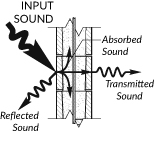Sound Insulation
 There are two properties of concrete masonry that make it useful as a noise-controlling material. The first characteristic is its effectiveness as a sound barrier that reflects sound waves. The second property is its ability to absorb sound and further minimize the sound that is transmitted through a concrete masonry wall. As shown in Figure 1, both of these characteristics combine to make concrete masonry extremely effective in preventing sound transmission over a wide range of frequencies.
There are two properties of concrete masonry that make it useful as a noise-controlling material. The first characteristic is its effectiveness as a sound barrier that reflects sound waves. The second property is its ability to absorb sound and further minimize the sound that is transmitted through a concrete masonry wall. As shown in Figure 1, both of these characteristics combine to make concrete masonry extremely effective in preventing sound transmission over a wide range of frequencies. Sound absorption is particularly important in auditoriums, concert halls and other locations where noise reflection needs to be minimized to control the sound generated within a room. The sound absorption coefficient defines how effectively a surface absorbs noise. A sound absorption coefficient of 0.25 indicates that 25% of the sound striking the surface is absorbed by the wall at the frequency being considered. The noise reduction coefficient (NRC) is the average of the sound absorption coefficient at frequencies of 250, 500, 1000 and 2000 hertz. Table 2.6.1 provides the approximate values of the NRC for some concrete masonry walls. The table shows that lighter material is more efficient in absorbing sound waves. Application of paint and other finishes to concrete masonry typically reduces the NRC value by increasing the amount of sound reflected by the wall.
TABLE 1: Approximate Noise Reduction Coefficients (NRC) for Unpainted Concrete Masonry Walls
| Surface Texture | |||
| Coarse | Medium | Fine | |
| Lightweight Concrete Masonry | 0.50 | 0.45 | 0.40 |
| Normal Weight Concrete Masonry | 0.28 | 0.27 | 0.26 |
1ASTM, “Standard Test Method for Laboratory Measurement of Airborne Sound Transmission Loss of Building Partition Elements”, Standard E90-09, Annual Book of ASTM Standards, Volume 04.06, ASTM International, West Conshohocken, Pennsylvania, 2014.
In lieu of the experimental procedure outlined in ASTM E90, empirical equations have been developed to estimate the STC ratings for various masonry walls. TMS 302, “Standard Method for Determining Sound Transmission Ratings for Masonry Walls”2 provides such relationships. For concrete masonry walls that have a thickness of 3 inches or greater, the STC rating is given by:
STC= 20.5W0.234 (1)
where W is the weight of the wall in psf. Unlike sound absorption, the ability of a wall to block sound improves with density. Table 2 provides the STC values using Equation (1) for some solid grouted walls constructed with normal weight concrete masonry units. STC values for walls constructed with different weight block, or for walls that are partially grouted may be estimated using the appropriate wall weight and Equation (1). Building codes generally require that the STC values between living units be no less than 40 to 50.
TABLE 2: Typical STC Ratings of Solid Grouted Masonry Walls Constructed with Medium Weight Concrete Masonry Units3
| Calculated STC Rating | |
| 6 | 53 |
| 8 | 57 |
| 10 | 60 |
| 12 | 62 |
2TMS Standards Development Committee, “Standard Method for Determining Sound Transmission Ratings for Masonry Walls”, The Masonry Society, Longmont, Colorado, 2012.
3Values taken from Commentary to TMS Standard TMS 0302-12, Table 7.3-4 Calculated STC Values for Concrete Masonry Walls, for cmu density of 120 pcf, and grout density of 140 pcf.
Angelus Block Co., Inc. supplies this information as an educational aid in understanding the benefits of concrete masonry construction and our products. It is the responsibility of the user to obtain engineering or other advisory services from licensed professionals as the basis for incorporating into any project any information, detail, or product offered herein.


 Fire Resistive Ratings
Fire Resistive Ratings